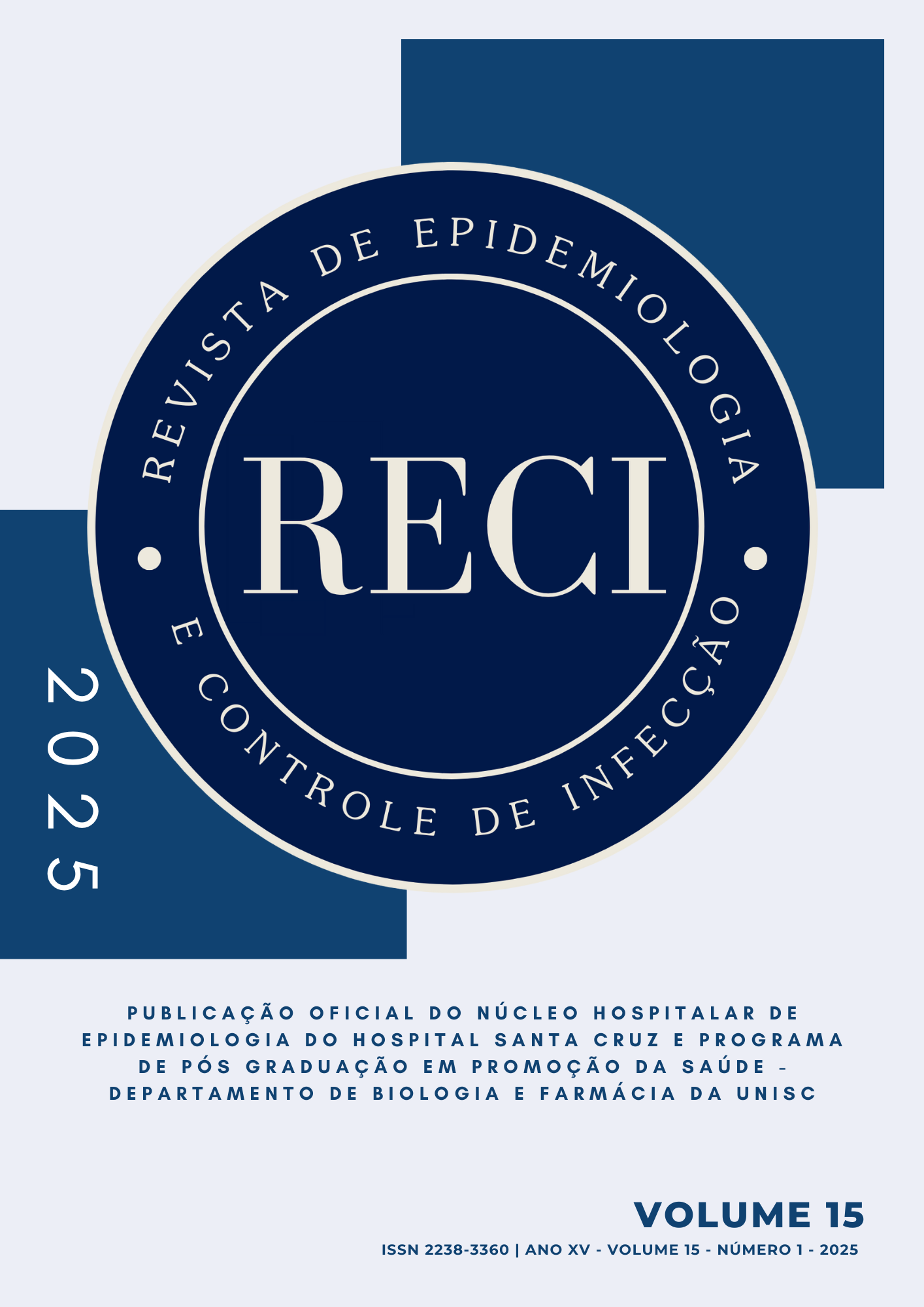Taxa de incidência de infecção de sítio cirúrgico relacionada a indicadores de qualidade
DOI:
https://doi.org/10.17058/reci.v15i1.19503Palavras-chave:
Infecção de Ferida Operatória, Indicadores de Qualidade em Assistência à Saúde, Enfermagem PerioperatóriaResumo
Justificativa e Objetivos: é importante mensurar e relacionar a teoria e a prática aplicada no ambiente de trabalho através de indicadores de qualidade em saúde como uma assistência adequada ao paciente cirúrgico e prevenção de futuras infecções. O objetivo deste estudo foi analisar os indicadores de qualidade relacionados à prevenção da infecção de sítio cirúrgico de um hospital de ensino. Métodos: estudo transversal, analítico, prospectivo e quantitativo, com embasamento teórico na tríade de estrutura, processo e resultado. Foi realizado no centro cirúrgico de um hospital público, universitário, do Sul do Brasil, vinculado ao Sistema Único de Saúde. A amostra do estudo incluiu as equipes cirúrgicas e o centro cirúrgico do hospital de estudo, e sua composição foi dada com base nos critérios de inclusão, como cirurgia realizada durante o período diurno (das 07:00 às 19:00), de segunda a sexta-feira, com caráter eletivo, durante um período de três meses, no ano de 2022 (setembro a novembro). Resultados: foram 283 procedimentos cirúrgicos eletivos, com destaque para procedimentos realizados sem quebra de técnica asséptica do campo operatório relatada em ficha transoperatória (97,53%; 276). O centro cirúrgico estudado apresentou uma estrutura operacional incompleta aos padrões de práticas seguras recomendadas. A amostra identificou 22,30% (63) dos pacientes com infecção de sítio cirúrgico. Conclusão: a análise dos indicadores demonstrou a necessidade de adequação de itens relacionados à estrutura e processo (dispensador de antisséptico adequado e torneiras acionadas sem contato manual), além da revisão de protocolos operacionais padrão.
Downloads
Referências
Von Vogelsang AC, Swenne CL, Gustafsson BÅ, et al. Operating theatre nurse specialist competence to ensure patient safety in the operating theatre: A discursive paper. Nurs Open. 2019; 7 (2): 495-502. DOI: https://doi.org/10.1002/nop2.424
Lee KC, Sokas CM, Streid J, et al. Quality Indicators in Surgical Palliative Care: A Systematic Review. Jurnal Pain Symptom Manage. 2021; 62 (3): 545-58. DOI: https://doi.org/10.1016/j.jpainsymman.2021.01.122
Donabedian, A. An introduction to quality assurance in health care. 1 ed. University Press (UK): Oxford; 1980.
Glowka L, Tanella A, Hyman JB. Quality indicators and outcomes in ambulatory surgery. Current Opinion in Anaesthesiology. 2023; 36 (6): 624-29 DOI: https://doi.org/10.1097/aco.0000000000001304
Báo ACP, Amestoy SC, Mourão GMSS de, et al. Quality indicators: tools for the management of best practices in health. Rev. Bras. Enferm. 2019; 72 (2): 360-6 [Internet]. DOI: https://doi.org/10.1590/0034-7167-2018-0479
Brasil. Agência Nacional de Vigilância Sanitária (ANVISA). Critérios diagnósticos de infecções relacionadas à assistência à saúde. 1. ed. Brasília, 2013 [Internet]. URL: https://bvsms.saude.gov.br/bvs/publicacoes/criterios_diagnosticos_infeccoes_assistencia_saude.pdf
Mengistu DA, Alemu A, Abdukadir AA, et al. Global Incidence of Surgical Site Infection Among Patients: Systematic Review and Meta-Analysis. Inquiry Journal of Health Care Organization, Provision, and Financing. 2023; (60) [Internet]. DOI: https://doi.org/10.1177/00469580231162549
Cavalcanti AC, Freitas JJG, Madeira JF, et al. Atuação do enfermeiro no controle de fatores de riscos e prevenção da infecção de sítio cirúrgico: uma revisão integrativa. Rev. Educ. Ci. e Saúde. 2019; (6)1: 36-55 [Internet]. DOI: http://dx.doi.org/10.20438/ecs.v6i1.162
WHO. Infection prevention and control. World Health Organization. Geneva; 2022. URL: https://www.who.int/publications/i/item/9789240051164
Magalhães Costa EA, Moreira LL, Gusmão MEN. Incidência de infecção de sítio cirúrgico em hospital dia: coorte de 74.213 pacientes monitorados. Rev SOBECC. 2019; 24(4): 211-6 [Internet]. DOI: https://doi.org/10.5327/Z1414-4425201900040006
Gomes JA, Martins MM, Tronchin DMR, et al. Avaliação da qualidade do centro cirúrgico na estrutura, processo e resultados. Rev. Cogitare Enfermagem. 2021; (26) [Internet]. DOI: https://doi.org/10.5380/ce.v26i0.71083
Associação Paulista de Epidemiologia e Controle de Infecção Relacionada à Assistência à Saúde (APECIH). Limpeza, desinfecção e esterilização de produtos para saúde (PPS). 4a ed. São Paulo: APECIH; 2021.
Gomes ACC. Modelagem por redes complexas da dinâmica das infecções de sítio cirúrgico. 94p. 2019. Dissertação (mestrado) – Repositório Universidade Federal de Pernambuco, Centro de Ciências da Saúde. Programa de pós-graduação em Cirurgia. Recife [Internet]. URL: https://repositorio.ufpe.br/bitstream/123456789/35149/1/DISSERTA%c3%87%c3%83O%20Andr%c3%aaza%20Cavalcanti%20Correia%20Gomes.pdf
Hathway A, Papakonstantis I, Bruce-Konuah A, et al. Experimental and Modelling Investigations of Air Exchange and Infection Transfer due to Hinged-Door Motion in Office and Hospital Settings. International Journal of Ventilation. 2015; 14(2): 127–140. DOI: https://doi.org/10.1080/14733315.2015.11684075
Dos Santos Maciel LÍ, da Cruz IP, de Oliveira LSB, et al. A influência da infraestrutura hospitalar na prevenção da infecção relacionadas à assistência de enfermagem. Revista Ibero-Americana de Humanidades, Ciências e Educação. 2024; 10(4): 327-342. DOI: https://doi.org/10.51891/rease.v10i4.13454
De Souza KV, Serrano SQ. Saberes dos enfermeiros sobre prevenção de infecção do sítio cirúrgico. Rev SOBECC. 2020; 25(1): 11-6 [Internet]. DOI: https://doi.org/10.5327/Z1414-4425202000010003
Silveira KB. Adesão á antissepsia cirúrgica das mãos em um hospital universitário. 41p. 2023. Trabalho de Conclusão de Curso (Especialização). Programa de Residência Integrada Multiprofissional em Saúde – Repositório Universidade Federal do Rio Grande do Sul. Porto Alegre [Internet]. URL: https://lume.ufrgs.br/bitstream/handle/10183/271248/001194929.pdf?sequence=1
Wang Q, Cao M, Tao H, et al. Evidence-based guideline for the prevention and management of perioperative infection. Journal Evid Based Med. 2023; 16 (1): 50-67. DOI: https://doi.org/10.1111/jebm.12514
Trentini AH, Schueda MA, Reis MR. Indicadores como aliados na gestão do centro cirúrgico. Brazilian Journal of Development. 2020; 9(6): 69122-29 [Internet]. DOI: https://doi.org/10.34117/bjdv6n9-382
Xavier LFD, Medeiros AS, Melo MCDSF, et al. Projeto de melhoria para redução de infecções de sítio cirúrgico: um estudo de coorte retrospectivo. Revista do Colégio Brasileiro de Cirurgiões. 2023; 5: e20233380. DOI: https://doi.org/10.1590/0100-6991e-20233380-en
Downloads
Publicado
Edição
Seção
Licença
Copyright (c) 2025 Beatriz Zago Lupepsa, Gabriela Encarnação Leandro, Helenize Ferreira Lima Leachi, Marília Ferrari Conchon, Cibele Cristina Tramontini

Este trabalho está licenciado sob uma licença Creative Commons Attribution 4.0 International License.
The author must state that the paper is original (has not been published previously), not infringing any copyright or other ownership right involving third parties. Once the paper is submitted, the Journal reserves the right to make normative changes, such as spelling and grammar, in order to maintain the language standard, but respecting the author’s style. The published papers become ownership of RECI, considering that all the opinions expressed by the authors are their responsibility. Because we are an open access journal, we allow free use of articles in educational and scientific applications provided the source is cited under the Creative Commons CC-BY license.


